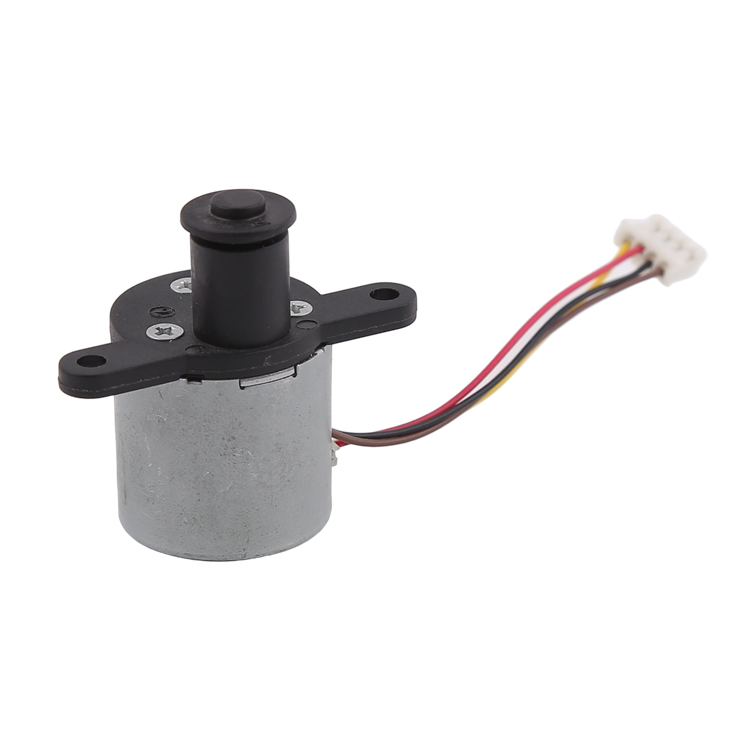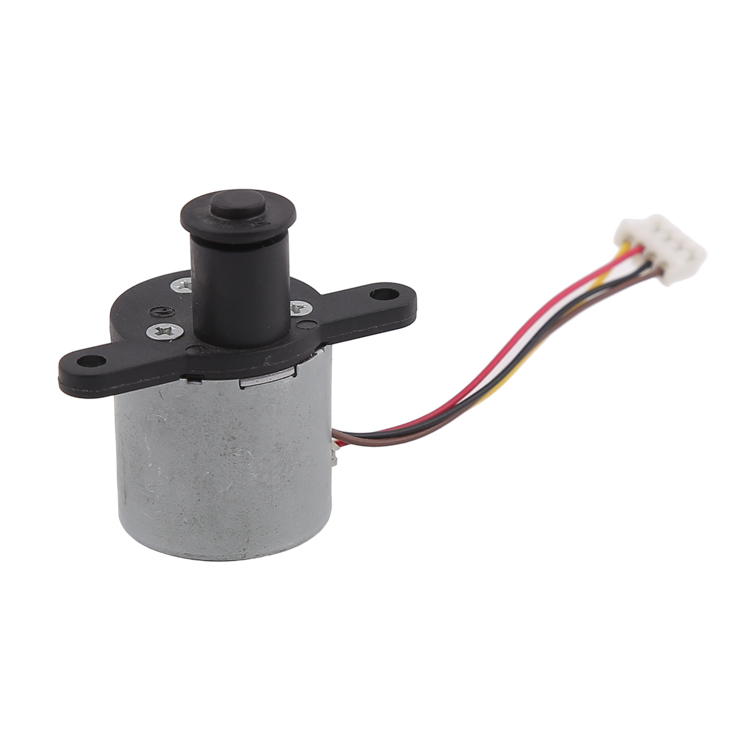બુદ્ધિશાળી થર્મોસ્ટેટ, આધુનિક ઘર અને ઔદ્યોગિક ઓટોમેશનના અનિવાર્ય ભાગ તરીકે, જીવનની ગુણવત્તા અને ઉત્પાદન કાર્યક્ષમતા સુધારવા માટે તેનું ચોક્કસ તાપમાન નિયંત્રણ કાર્ય ખૂબ મહત્વનું છે. બુદ્ધિશાળી થર્મોસ્ટેટના મુખ્ય ડ્રાઇવિંગ ઘટક તરીકે, 25mm પુશ હેડ સ્ટેપિંગ મોટરના થર્મોસ્ટેટમાં કાર્યકારી સિદ્ધાંત અને એપ્લિકેશન અન્વેષણ કરવા યોગ્ય છે.
પ્રથમ, મૂળભૂત કાર્ય સિદ્ધાંત25 મીમી પુશ હેડ સ્ટેપર મોટર
સ્ટેપિંગ મોટર એક ઓપન-લૂપ કંટ્રોલ એલિમેન્ટ છે જે ઇલેક્ટ્રિકલ પલ્સ સિગ્નલને કોણીય ડિસ્પ્લેસમેન્ટ અથવા લાઇન ડિસ્પ્લેસમેન્ટમાં રૂપાંતરિત કરે છે. નોન-ઓવરલોડના કિસ્સામાં, મોટરની ગતિ, સ્ટોપિંગ પોઝિશન ફક્ત પલ્સ સિગ્નલની આવર્તન અને પલ્સની સંખ્યા પર આધાર રાખે છે, અને લોડમાં થતા ફેરફારોથી પ્રભાવિત થતી નથી, એટલે કે, મોટરમાં પલ્સ સિગ્નલ ઉમેરો, મોટરને સ્ટેપ એંગલ પર ફેરવવામાં આવે છે. આ રેખીય સંબંધનું અસ્તિત્વ, સ્ટેપર મોટરની લાક્ષણિકતાઓ સાથે જોડાયેલું છે જેમાં સંચિત ભૂલ વિના ફક્ત સામયિક ભૂલ હોય છે, જે સ્ટેપર મોટર સાથે ગતિ, સ્થિતિ અને અન્ય નિયંત્રણ ક્ષેત્રોનું નિયંત્રણ ખૂબ જ સરળ બનાવે છે.
આ25 મીમી પુશ હેડ સ્ટેપિંગ મોટરનામ પ્રમાણે, તેનો પુશ હેડ વ્યાસ 25 મીમી છે, જે નાના કદ અને ઉચ્ચ ચોકસાઈ પ્રદાન કરે છે. મોટર કંટ્રોલર પાસેથી પલ્સ સિગ્નલો પ્રાપ્ત કરીને ચોક્કસ કોણીય અથવા રેખીય વિસ્થાપન પ્રાપ્ત કરે છે. દરેક પલ્સ સિગ્નલ મોટરને એક નિશ્ચિત કોણ, સ્ટેપ એંગલ દ્વારા ફેરવે છે. પલ્સ સિગ્નલોની આવર્તન અને સંખ્યાને નિયંત્રિત કરીને, મોટરની ગતિ અને સ્થિતિને ચોક્કસ રીતે નિયંત્રિત કરી શકાય છે.
બીજું, ઇન્ટેલિજન્ટ થર્મોસ્ટેટમાં 25 મીમી પુશ હેડ સ્ટેપિંગ મોટરનો ઉપયોગ
બુદ્ધિશાળી તાપમાન નિયંત્રકોમાં,25 મીમી પુશ-હેડ સ્ટેપિંગ મોટર્સતાપમાનનું ચોક્કસ નિયંત્રણ પ્રાપ્ત કરવા માટે મુખ્યત્વે વાલ્વ, બેફલ્સ વગેરે જેવા એક્ટ્યુએટર ચલાવવા માટે વપરાય છે. ચોક્કસ કાર્ય પ્રક્રિયા નીચે મુજબ છે:
તાપમાન સંવેદના અને સિગ્નલ ટ્રાન્સમિશન
સ્માર્ટ થર્મોસ્ટેટ સૌપ્રથમ તાપમાન સેન્સર દ્વારા વાસ્તવિક સમયમાં ઓરડાના તાપમાનને અનુભવે છે અને તાપમાન ડેટાને વિદ્યુત સંકેતોમાં રૂપાંતરિત કરે છે. આ વિદ્યુત સંકેતો પછી નિયંત્રકમાં ટ્રાન્સમિટ થાય છે, જે પ્રીસેટ તાપમાન મૂલ્યની તુલના વર્તમાન તાપમાન મૂલ્ય સાથે કરે છે અને ગોઠવવા માટેના તાપમાન તફાવતની ગણતરી કરે છે.
પલ્સ સિગ્નલોનું ઉત્પાદન અને પ્રસારણ
કંટ્રોલર તાપમાનના તફાવતના આધારે અનુરૂપ પલ્સ સિગ્નલો જનરેટ કરે છે અને તેમને ડ્રાઇવ સર્કિટ દ્વારા 25 મીમી પુશ હેડ સ્ટેપર મોટરમાં ટ્રાન્સમિટ કરે છે. પલ્સ સિગ્નલોની આવર્તન અને સંખ્યા મોટરની ગતિ અને વિસ્થાપન નક્કી કરે છે, જે બદલામાં એક્ટ્યુએટર ઓપનિંગનું કદ નક્કી કરે છે.
એક્ટ્યુએટર ક્રિયા અને થર્મોરેગ્યુલેશન
પલ્સ સિગ્નલ પ્રાપ્ત કર્યા પછી, 25 મીમી પુશ-હેડ સ્ટેપર મોટર ફેરવવાનું શરૂ કરે છે અને એક્ટ્યુએટર (દા.ત. વાલ્વ) ને દબાણ કરે છે જેથી તે મુજબ ઓપનિંગ ગોઠવી શકાય. જ્યારે એક્ટ્યુએટરનું ઓપનિંગ વધે છે, ત્યારે રૂમમાં વધુ ગરમી અથવા ઠંડી પ્રવેશે છે, આમ ઘરની અંદરનું તાપમાન વધે છે અથવા ઘટે છે; તેનાથી વિપરીત, જ્યારે એક્ટ્યુએટરનું ઓપનિંગ ઘટે છે, ત્યારે ઓછી ગરમી અથવા ઠંડી રૂમમાં પ્રવેશે છે, અને ઘરની અંદરનું તાપમાન ધીમે ધીમે સેટ મૂલ્યમાં રૂપાંતરિત થાય છે.
પ્રતિસાદ અને બંધ-લૂપ નિયંત્રણ
ગોઠવણ પ્રક્રિયા દરમિયાન, તાપમાન સેન્સર સતત ઘરની અંદરના તાપમાનનું નિરીક્ષણ કરે છે અને રીઅલ-ટાઇમ તાપમાન ડેટા નિયંત્રકને પાછો આપે છે. ચોક્કસ તાપમાન નિયંત્રણ પ્રાપ્ત કરવા માટે નિયંત્રક પ્રતિસાદ ડેટા અનુસાર પલ્સ સિગ્નલ આઉટપુટને સતત ગોઠવે છે. આ બંધ-લૂપ નિયંત્રણ બુદ્ધિશાળી તાપમાન નિયંત્રકને વાસ્તવિક પર્યાવરણીય પરિસ્થિતિઓમાં ફેરફાર અનુસાર એક્ટ્યુએટરના ઉદઘાટનને આપમેળે ગોઠવવાની મંજૂરી આપે છે, ખાતરી કરે છે કે ઘરની અંદરનું તાપમાન હંમેશા સેટ શ્રેણીમાં જાળવવામાં આવે છે.
ત્રીજું, 25 મીમી પુશ હેડ સ્ટેપિંગ મોટરના ફાયદા અને બુદ્ધિશાળી તાપમાન નિયંત્રકમાં તેના ફાયદા
ઉચ્ચ-ચોકસાઇ નિયંત્રણ
સ્ટેપર મોટરની ચોક્કસ કોણીય અને રેખીય વિસ્થાપન લાક્ષણિકતાઓને કારણે, 25 મીમી પુશ હેડ સ્ટેપર મોટર એક્ટ્યુએટર ઓપનિંગનું ચોક્કસ નિયંત્રણ પ્રાપ્ત કરી શકે છે. આ બુદ્ધિશાળી થર્મોસ્ટેટને તાપમાનનું ચોક્કસ ગોઠવણ પ્રાપ્ત કરવા સક્ષમ બનાવે છે, તાપમાન નિયંત્રણની ચોકસાઈ અને સ્થિરતામાં સુધારો કરે છે.
ઝડપી પ્રતિભાવ
સ્ટેપર મોટરની ઉચ્ચ પરિભ્રમણ ગતિ અને પ્રવેગકતા 25 મીમી પુશ-હેડ સ્ટેપર મોટરને પલ્સ સિગ્નલ પ્રાપ્ત કર્યા પછી ઝડપથી પ્રતિસાદ આપવા અને એક્ટ્યુએટર ઓપનિંગને ઝડપથી ગોઠવવા સક્ષમ બનાવે છે. આ સ્માર્ટ થર્મોસ્ટેટને ટૂંકા સમયમાં સેટ તાપમાન સુધી પહોંચવામાં મદદ કરે છે અને તાપમાન નિયંત્રણની કાર્યક્ષમતામાં સુધારો કરે છે.
ઊર્જા બચત અને પર્યાવરણીય સંરક્ષણ
એક્ટ્યુએટરના ઓપનિંગને સચોટ રીતે નિયંત્રિત કરીને, સ્માર્ટ થર્મોસ્ટેટ બિનજરૂરી ઉર્જા બગાડને ટાળવા અને ઉર્જા બચત અને પર્યાવરણીય સંરક્ષણને સાકાર કરવામાં સક્ષમ છે. તે જ સમયે, 25 મીમી એક્ટ્યુએટર સ્ટેપર મોટરમાં ઉચ્ચ ઉર્જા કાર્યક્ષમતા ગુણોત્તર છે, જે ઉર્જા વપરાશ ઘટાડવામાં પણ મદદ કરે છે.
IV. નિષ્કર્ષ
સારાંશમાં, સ્માર્ટ થર્મોસ્ટેટ્સમાં 25 મીમી પુશ-હેડ સ્ટેપર મોટર્સનો ઉપયોગ તાપમાનનું ચોક્કસ, ઝડપી અને ઊર્જા બચત નિયંત્રણ પ્રાપ્ત કરે છે. સ્માર્ટ હોમ અને ઔદ્યોગિક ઓટોમેશનના સતત વિકાસ સાથે, 25 મીમી પુશ-હેડ સ્ટેપર મોટર્સ વધુ ક્ષેત્રોમાં મહત્વપૂર્ણ ભૂમિકા ભજવશે અને તાપમાન નિયંત્રણ ટેકનોલોજીની સતત પ્રગતિને પ્રોત્સાહન આપશે.
પોસ્ટ સમય: એપ્રિલ-૧૦-૨૦૨૪


